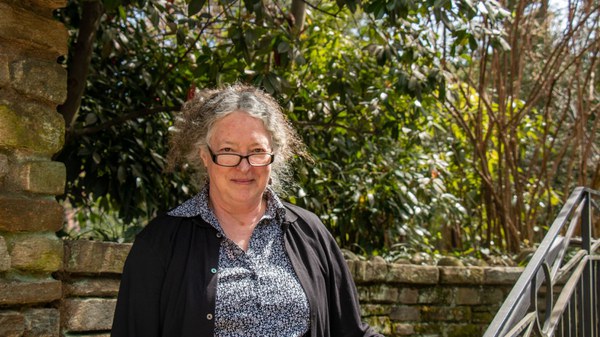Ann Peters, an independent researcher affiliated with the Penn Museum, was a 2021–2022 fellow in Pre-Columbian Studies. Her research report, “Paracas Necropolis Mortuary Regalia, Imagery, and Sociopolitical Networks,” explored mortuary practices in tombs at Paracas as indicators of sociocultural roles and relationships in life and death.
Q&A with Ann Peters
What is Paracas and the significance of the tombs there?
Paracas is a peninsula on the south coast of Peru, at the transition between two different ocean environments. In this project and in most of my work, I study the materials excavated from cemeteries in the area by Julio Cesar Tello, considered one of the founders of Peruvian archaeology, in the 1920s. Most of his work is in the museum that he founded in Peru, but he also sent some objects from Paracas to the United States. The dry and foggy environment of Paracas creates a stable environment that makes the textiles from the site some of the best preserved in the world.
I’m interested in understanding who made these textiles and the social organization around their making. They were not made by a centralized group of people, they were made by many different communities in many different styles, so they give us insight into a complex social world for which we have no other source for understanding other than this and other cemeteries in the region at the time that preserved the textiles.
What is unique about the textile evidence at Paracas?
Many books and articles have been written about the textiles of Paracas—on their design principles, intellectual history, cosmology, and textile finesse—because they’re beautifully made. I am interested in what they tell us about the society that created them. Many people assume these are the fabulous tombs of the elite of ancient Peru, but we need to unpack that. Many of these beautifully made textiles were placed around some—not all—of the dead. Some were placed long after people had died, so the placement of the textiles might reflect the individual’s status in life as much as their significance after death. It’s like the equestrian statue of war in Europe: the person who is commemorated in that statue did significant things and was a social leader in their life, but much of what was done to keep them around and express their significance happened decades later.
I am particularly fond of the materials of Tomb 28, for example, for what they tell us about mortuary practices for women. The tomb was unwrapped in 1930, when Tello had already unwrapped several tombs with large mortuary bundles that all had the same kind of regalia, all wrapped around men, so he thought he knew what would be inside. Instead, he unwrapped a substantial bundle that included women’s clothing—though at the time they didn’t even know what women’s regalia looked like. They then unwrapped many other women, from which they defined different articles of clothing what a high-ranking woman would be, which women seemed to hold special ritual power. But they never published on the subject, perhaps because they were trying to please the crowd and give people the sorts of objects they already imagined would mark important (male) individuals.
The individual in Tomb 28 was wrapped in large mantle-like cloths and headcloths. Some were not embroidered: instead, they have fine woven borders in contrasting colors, a design different than any garment found with men. She did not have weapons, but she did have gold ornaments. The dresses and mantles indicate she was part of the Topara tradition, which is predominant in this particular cemetery, whereas the headcloths indicate she was also part of the Nasca tradition, which is the group that was coming into power at the time. To me, this suggests a pattern of interrelationship, such as marriages, that you see in many of the tombs. We might think of all these groups as trading or warring with each other, but we also find biophysical and cultural evidence that people from different traditions lived and died in the same places.
What does this reveal about their mortuary practices and social practices at large?
We have material residue of the mortuary rituals, and they can tell us something about the actual, living people: who came to the ritual and what they brought. By studying the diverse array of objects we can learn about those people’s lives and where they came from. It gives a sense of the social role of the dead—the dead themselves played an important social and political role in the lives of the living. More broadly, it’s exciting to read the records of Tello right around the time of the formation of the field of archaeology. The standards were just being evolved, and from reading their letters and field notes you can see Tello and his team developing their methods: making mistakes, correcting themselves, systematizing the information, improving their approach.
May Wang was the 2020–2022 postgraduate writing and reporting fellow. Photo by Emily Orr, 2021–2022 humanities fellow.

